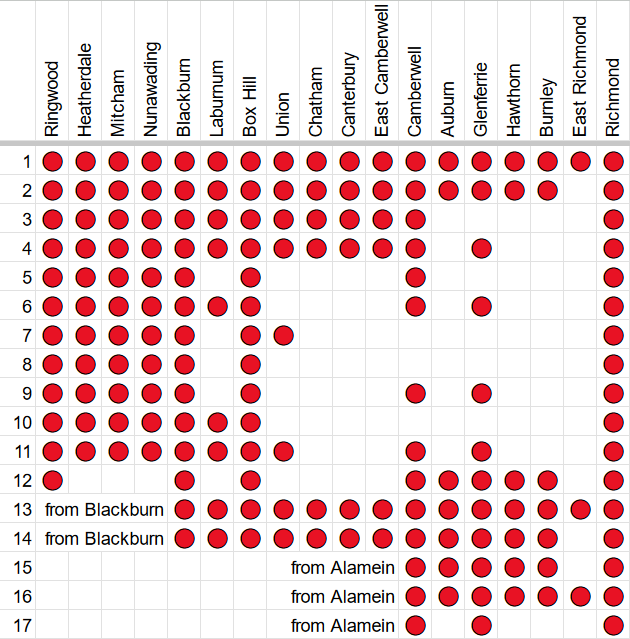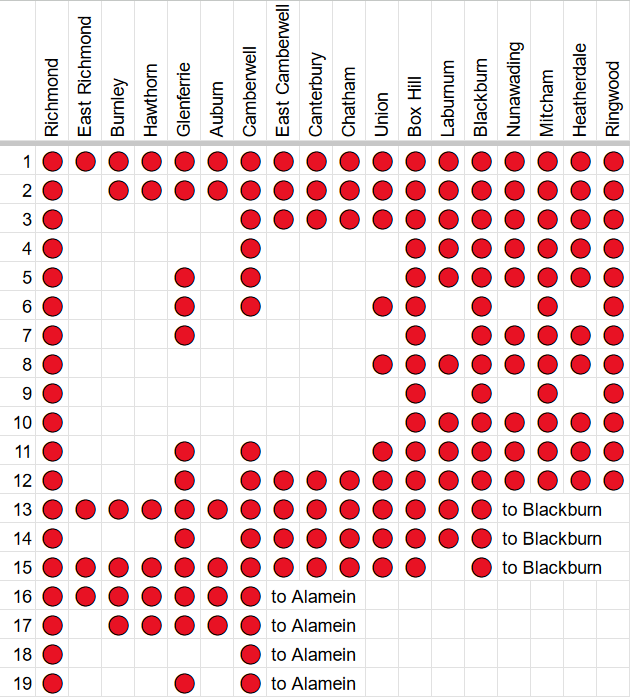A common view is that rail stopping patterns should be kept as simple as possible.
Lots of complex patterns are difficult for passengers to understand… and drivers and other staff as well. And when used with frequent services, they require everything to be perfectly on time for it all to work well.
I was recently speaking to a bunch of rail people from (undisclosed) visiting Melbourne, and remarked that the Ringwood line has something like 15 stopping patterns.
I’m not sure they would have believed me, but one of them confirmed he’d seen it himself.
Checking afterwards, I was not quite right. By my count, between Ringwood and Richmond, there are 17 inbound, and 19 outbound patterns.
That’s excluding different origin/termination points beyond Ringwood, and excluding the various City Loop combinations.
Inbound:

Outbound:

All I can say is: this is ridiculous.
Even accounting for various weird counter-peak patterns, and some trains branching off at Alamein or terminating at Blackburn, it’s still ridiculous.
Back in 2006 a PTUA publication noted 13 outbound patterns between Richmond and Ringwood. At one point the rumour was that the merging of Mont Albert and Surrey Hills stations to become Union station would trigger a rewrite, reducing the complexity, but it seems to have gone backwards.
I’d also note that Chatham, Canterbury and East Camberwell get some quite infrequent services during peak thanks to the numbers of expresses, and about half the stoppers branching off at Alamein. Keeping passengers at Union happy might be what’s caused so many express trains to stop there.
Comparing outbound stopping patterns for the longest lines:
- Ringwood (18 stations): 19 patterns
- Dandenong (19 stations): 6 patterns, including short runs to/from Westall, and one questionable run that skips Huntingdale in the morning peak
- Frankston (27 stations): 7 patterns, including some trains to/from Moorabbin, Cheltenham, Mordialloc and Carrum
It’s handy to have a simple clockface train timetable that is possible to memorise, but failing that, at least the stopping patterns should be easy to understand.
Really, they need to rationalise the Ringwood line timetable, and get the stopping patterns down to no more than a handful in each direction.


19 replies on “Stopping patterns”
We were promised that more trains would stop at Union since it is now a premium station staffed all day, but posts to the local facebook group would suggest that this hasn’t eventuated – or it’s no more than 1 extra train in the morning and afternoon.
As a driver I totally agree.
Recently, we’ve had a spate of incorrect stops or non-stops by drivers. When one looks at the data of these occurrences, it’s linked to repeat runs by that driver over the same line; different stopping patterns though.
One thing they can do is give each pattern a code and use that, like some overseas networks do.
Or stick with the old arrangement, but simplify it to no more than one express section on each line, eg. a train running ‘express Richmond to Box Hill then all stops to Ringwood’, on the Frankston/Dandenong lines, the express trains could alternate between each, instead of the myriad complex announcements that just piss off and confound customers.
My cynical mind suggests that the express train stop at Camberwell merely to ingratiate the marginal electoral voters.
One night, I was doing extra work and I got a tram from Port Melbourne to Box Hill and got a train at said station, thinking it would stop at Burnley to change to a Glen Waverley train to Holmesglen, and guess what? It skipped Burnley, which I was unaware of. I think with the opening of Union station, all relevant parties (Public Transport Victoria and Metro) should’ve fixed the timetable, but alas, they didn’t, and sadly, Lilydale and Belgrave lines still have a mess of all of these variations.
A couple of weeks ago, I was on the Werribee line (got on at Footscray), thinking that the train I boarded stopped at Hoppers Crossing, but it didn’t (fortunately, I got the jist and got off at Laverton before the train ran express from Laverton to Werribee).
My home line (Sunbury) is a lot easier to understand, with almost consistent patterns (apart from peak hour where Tottenham, West Footscray and Middle Footscray are skipped), but we are due to get a massive change either later this year or early next year when the Metro Tunnel opens (this correspondent is saying sometime between September and December this year) and Sunbury is combined with Cranbourne and Pakenham lines (in fact, two peak services from Sunbury continues on to Pakenham).
Just hope that they fix the mess with the Lilydale and Belgrave lines and have more consistency with the stopping pattern.
What are the benefits, if any, of common stopping patterns?
If I use a particular journey regularly, all services split into “close to optimal”, “slow” and “doesn’t stop here”.
If I journey somewhere I’m not familiar with, Google Maps (and other modern trip planning tools) abstract everything away.
And even while trains still require humans to drive, stopping patterns can be hinted by the on-board equipment (*).
Whereas optimising the patterns is a topic of research and presumably can make the whole system more efficient (*).
(*): Melbourne isn’t and is unlikely to need to be cutting-edge here, however sadly.
Think that’s bad? I’m pretty sure V/Line’s service to Waurn Ponds via Deer Park, Tarneit and Geelong outdoes it.
Completely agree with you Daniel and reversing the direction of services through the loop around lunchtime causes confusion too. Let’s have the same stopping pattern all day, every day.
Late at night and on weekends, #2 should be replaced with #1 so that they can fix the hugely uneven timetable for trains going from the city loop to Richmond, and better enable transfers to Sandringham and Frankston trains and route 78 trams.
Make use of that third track already. Death to the half-hourly timetable too.
*Alamein/Blackburn trains stopping all stations to the city full-time.
*Lilydale/Belgrave/Ringwood trains running express Blackburn-Box Hill-Camberwell-Richmond full-time with the express track installed at Laburnum.
*Up/down local lines upgraded to 80 km/h on the straights in line with the centre track. Currently the local lines are a pathetic 55 km/h from Richmond to Camberwell and 65 km/h to Box Hill. Frankston line expresses feel like a stealth bomber by comparison, even when it’s a clapped out Comeng (or maybe it’s just the sound of the traction motors sounding like an F1 car).
Completely agree. Melbourne is a mess of stopping patterns, and if the rail system is ever to operate as a high frequency, turn up and go metro, most of these stopping patterns need to be weeded out. It can be very annoying when you go wizzing past your station because you’ve gotten confused about where it’s stopping.
Out east, the Alamein line doesn’t help things, that’s been a thorn in the side of more frequent services beyond for a long time. In the 70’s there was a proposal to remove a track at the north end of the line and build a single platform connected to East Camberwell only 30m away, instead of changing at Camberwell. Then in the 80’s, the Cain government, following the conversion of the St Kilda line, proposed also converting Alamein to light rail and running into the city via either Burwood or Bakers rd.
Wouldn’t it be better if the Belgrave/Lilydale lines permanently ran express from Richmond to Glenferrie, Glenferrie to Camberwell then stop all stations to Belgrave/Lilydale,
And have the Alamein line open all day every day like other lines to stop all stations to Flinders Street?
I also wonder if it would be useful to remove Upfield services from the City Loop and just have it continue through Southern Cross/Flinders Street and connect with the Alamein line, similar to the Frankston-Werribee line currently?
It’s actually even worse than your diagram would suggest. Some outbound non-PSR services stop Richmond, Camberwell, Glenferrie, Box Hill, Ringwood only. These should at least stop at Blackburn and Mitcham too, to fit in with one of the existing stopping patterns.
I often see Melbourne’s system described as a “commuter-metro hybrid” with “metro-like frequencies in the inner city” yet it is not uncommon for me to wait more than 15 minutes during peak hour to get a train from Burnley to Glenferrie, while watching 6 to 7 half empty express services speeding past in that time. I wonder what sort of trade off we get on service frequency to deliver slightly faster services to far-out stations?
It can get worse. It can get ‘degraded mode’ worse.
The “Best” service I ever took was a degraded mode crush capacity train at Parliament, which went express Parliament to Camberwell (YES it expressed Richmond), Camberwell to Box Hill, Box Hill to Ringwood, Terminated at Ringwood.
Very convenient for few people except me, who needed to get to Ringwood.
My station is Heatherdale and I have to be careful I’m not on one of the very small number of outbound services which skip Heatherdale (and Nunawading). I’m not sure how much is gained by literally a handful of services skipping two stations in the middle suburbs.
Adding Glenferrie to all stopping patterns would seem to make sense, as a station serving a major university campus and amidst a growing resident population.
And surely it makes sense for all Blackburn and Alamein services to stop all stations.
If the Alamein line branched at Box Hill, it would be more useful to service the inbetween stations whilst allowing express trains to go past. Unfortunately, branching at Camberwell leaves it somewhat in the lurch hence the shuttle. It truly would be best served by being converted to light rail, including a southern extension to Chadstone SC (connecting to a future Caulfield-Rowville light rail), and a Northern extension to Fairfield station.
From there, Box Hill/GW becomes an all day alternating pair at 10min frequencies each (5min combined to Burnley), whilst Belgrave/Lilydale run at 20min frequencies (10min combined) running express from Richmond to Camberwell to Box Hill, then all stops to Belgrave/Lilydale.
These are the standard 6am to 10pm frequencies. 10pm to 2am (Mon-Wed night) or 6am (Thur-Sun night) runs at 20min frequencies on all four lines. Peak hour aims to double the all-day frequency where possible (5min to Box Hill/GW, 10min to Belgrave/UFG and Lilydale/Mooroolbark)
Then slowly work towards Quad between Burnley/Box Hill, as well as removing the LX at Madden Grove and rebuilding the junction.
I’m curious how much these different stopping patterns cut down on railway capacity in order to reduce CBD- outer suburban trips by about 10 mins.
10 years ago, I was renting about 300M from the Hawthorn railway station. During weekday evening peak travel, the station was served by only the Blackburn and Alamein, 3 minutes apart, with a 20 minute gap between them.
What’s worse, they depart direct from Flinders street, and there is nothing to direct you to change at Richmond if you happen to be in the city loop. The first time coming home from Melbourne Central (working RMIT city campus), I waited an hour, wondering why on earth every train was going express!
[…] the basketcase Ringwood lines (where virtually all trains skip East Richmond but many stop at all other stations) they also use […]